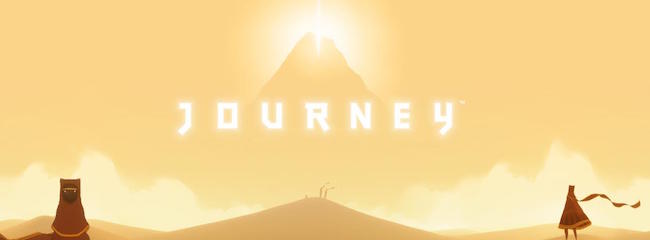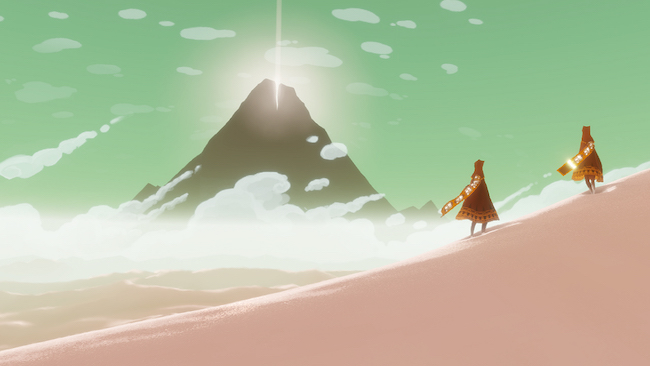
Few games have managed to instil in me the sort of joy and wonder that Journey delivers, especially in such a relatively short game. The deceptively simple design hides an incredibly rich experience that has left many a hardened gamer sobbing uncontrollably. The beauty of Journey is how subtly it tugs at your emotions through the course of the game. Each playthrough is made unique by the anonymous players you meet through the journey, which in itself becomes a part of the story. Journey was released to rapturous praise in 2012 on PSN by Thatgamecompany as part of a three game deal made with Sony. The PS4 port comes with sharpened visuals and a 60fps framerate and little else, but comes with the added benefit of being free for anyone who purchased it on PSN for PS3.
What has made Journey such a moving experience for so many people is how the game engages with players’ imaginations. Without any dialogue or explicit plot, the story unfolds through short expository cutscenes and the landscape itself. As a faceless, robed traveller, players start in a barren desert under a looming mountain – the obvious goal of your journey. The robe and accompanying scarf allows the traveller to fly and glide for a short time, drawing power from the strange cloth-like creatures and “plants” that inhabit the world. As the journey progresses, the desert gives way to a fallen civilisation while white-robed figures along the way attempt to show the land’s history through simple hieroglyph-style images. This, coupled with the actual experience of travelling through the landscape come together to allow players to come up with their own ideas on this civilisation’s downfall, and why it is the robed figure who is making the pilgrimage in the first place.

The story becomes truly unique when you meet a fellow traveller along the way. At first, they appear to just be there and along for the ride, but they soon become a clever way to build an emotional connection to the game over time. Journey is really a story in two parts – the classic civilisation destroyed in its hunger for power trope, and that of the journey itself. Both hit powerfully, but it’s the adventures with your fellow travellers that make the biggest impact.
The stripped-back minimalism of Journey and the power of its impact is a testament to the strength of Thatgamecompany’s design. Players are given subtle nudges in the direction of progress by visual cues while the abilities of the traveller are teased out through experimentation. The game then plays with these abilities and mechanics in its level design to affect not just the gameplay, but the atmosphere of each area. Journey starts out in a bleak, barren desert with jumping puzzles that require the use of the travellers chirps and scarf, which if carried through the entire game would have become tiresome. However, as the scenery and mood change, so does gameplay. As the jumping puzzles begin to wear out their welcome you’re sent speeding down sandy slopes seemingly just for pure exhilaration, complete with ramps and obstacles (that don’t hinder progress) to keep the fun factor high. The floating and cloth power mechanics are used masterfully later on to create an underwater motif with cloth creatures and plants seemingly swimming and swaying through the air, while the traveller is kept “afloat” by the scarf and cloak. Each area tells a story and slowly builds a bigger picture of the befallen civilisation, and more importantly your place in it.

At a certain point, other players will seamlessly and anonymously join your game (or you to their’s), with communication limited to the musical chirps the travellers make. Co-operation isn’t necessary to complete Journey, but the experience becomes all the more moving with a fellow traveller by your side. Travellers can aid each other with simple things such as pointing out scarf upgrades and safe routes, or by recharging each other’s scarves by being near each other. The bond is nurtured throughout the Journey without forcing co-operation down your throat, and is all the more heart-wrenching when you’re finally forced to part. During my PS4 playthrough, my buddy decided to quit right near the end, and I have to admit it really dampened the impact of the final sequence. Having already played Journey on PS3 multiple times, I already knew there wouldn’t be much left to surprise me, so I knew the game would have less effect on me, but I still couldn’t help but feel a bit deflated. Each subsequent playthrough adds to the patterns on the traveller’s cloak (purely cosmetic) and collecting every glowing orb will turn it white, just like that of the guides who silently narrate the story. I’ll just let you have a think about that.
The PS3 version of Journey was already a crisp and beautiful treat for the eyes, so the PS4 port is more a case of polishing the game to an even finer sheen. As existing PS3 Journey owners (PSN purchases only) get it for free on PS4, there’s little reason not to pick it up. Stark environments like the starting desert area are made beautiful with its glittering sand coupled with the reactive orchestral score by composer Austin Wintory and sound designer Steve Johnson. The power of the score cannot be overstated, and how well it accompanies Journey’s narrative – especially the euphoric finale. The travellers are anonymous and genderless, another smart move to break down any barriers between players, and move with a dancer’s grace (perhaps unlike many players). Their design is simple, yet also carefully considered to fit into Journey’s narrative.
 Beautiful art design
Beautiful art design
 Reactive orchestral score
Reactive orchestral score
 Skilful manipulation of emotions
Skilful manipulation of emotions
 Well thought out game design
Well thought out game design
 Sand surfing
Sand surfing
 It had to end
It had to end
 Co-op drop-outs can lessen the experience
Co-op drop-outs can lessen the experience
Now, as when it was first released, Journey remains a must-have for any Playstation owner library. It’s the sort of game that comes up in any “Are games art” conversation, and yet isn’t a tedious existential romp through the woods. Journey is both accessible to anyone and open to further interpretation for those who wish it. On the surface, Journey’s playtime seems a bit short for its cost, but there isn’t a second wasted nor do I believe the game’s impact have been any more if another five hours were tacked on. Quite often the narrative conventions we’re presented with in video games is limited to conflict and raw emotions, reactive rather than passive, and usually in a heavy-handed manner, so it’s important we have studios like Thatgamecompany that put story first.
DISCLAIMER: this game was supplied to us by the publisher, and reviewed on PS4 across 2 hours of gameplay.











